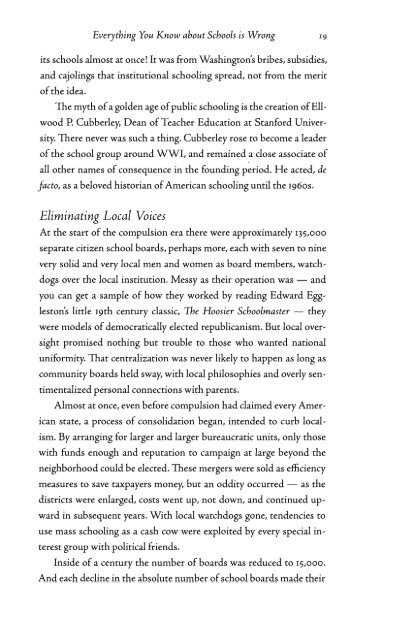john-taylor-gatto-weapons-of-mass-instruction
john-taylor-gatto-weapons-of-mass-instruction
john-taylor-gatto-weapons-of-mass-instruction
You also want an ePaper? Increase the reach of your titles
YUMPU automatically turns print PDFs into web optimized ePapers that Google loves.
Everything You Know about Schools is Wrong 19<br />
its schools almost at once! It was from Washington's bribes, subsidies,<br />
and cajolings that institutional schooling spread, not from the merit<br />
<strong>of</strong> the idea.<br />
The myth <strong>of</strong> a golden age <strong>of</strong> public schooling is the creation <strong>of</strong> Ellwood<br />
P. Cubberley, Dean <strong>of</strong> Teacher Education at Stanford University.<br />
There never was such a thing. Cubberley rose to become a leader<br />
<strong>of</strong> the school group around WWI, and remained a close associate <strong>of</strong><br />
all other names <strong>of</strong> consequence in the founding period. He acted, de<br />
facto, as a beloved historian <strong>of</strong> American schooling until theI960s.<br />
Eliminating Local Voices<br />
At the start <strong>of</strong> the compulsion era there were approximately 135,000<br />
separate citizen school boards, perhaps more, each with seven to nine<br />
very solid and very local men and women as board members, watchdogs<br />
over the local institution. Messy as their operation was - and<br />
you can get a sample <strong>of</strong> how they worked by reading Edward Eggleston's<br />
little 19th century classic, The Hoosier Schoolmaster - they<br />
were models <strong>of</strong> democratically elected republicanism. But local oversight<br />
promised nothing but trouble to those who wanted national<br />
uniformity. That centrali:z;ation was never likely to happen as long as<br />
community boards held sway, with local philosophies and overly sentimentalized<br />
personal connections with parents.<br />
Almost at once, even before compulsion had claimed every American<br />
state, a process <strong>of</strong> consolidation began, intended to curb localism.<br />
By arranging for larger and larger bureaucratic units, only those<br />
with funds enough and reputation to campaign at large beyond the<br />
neighborhood could be elected. These mergers were sold as efficiency<br />
measures to save taxpayers money, but an oddity occurred - as the<br />
districts were enlarged, costs went up, not down, and continued upward<br />
in subsequent years. With local watchdogs gone, tendencies to<br />
use <strong>mass</strong> schooling as a cash cow were exploited by every special interest<br />
group with political friends ..<br />
Inside <strong>of</strong> a century the number <strong>of</strong> boards was reduced to 15,000.<br />
And each decline in the absolute number <strong>of</strong> school boards made their


